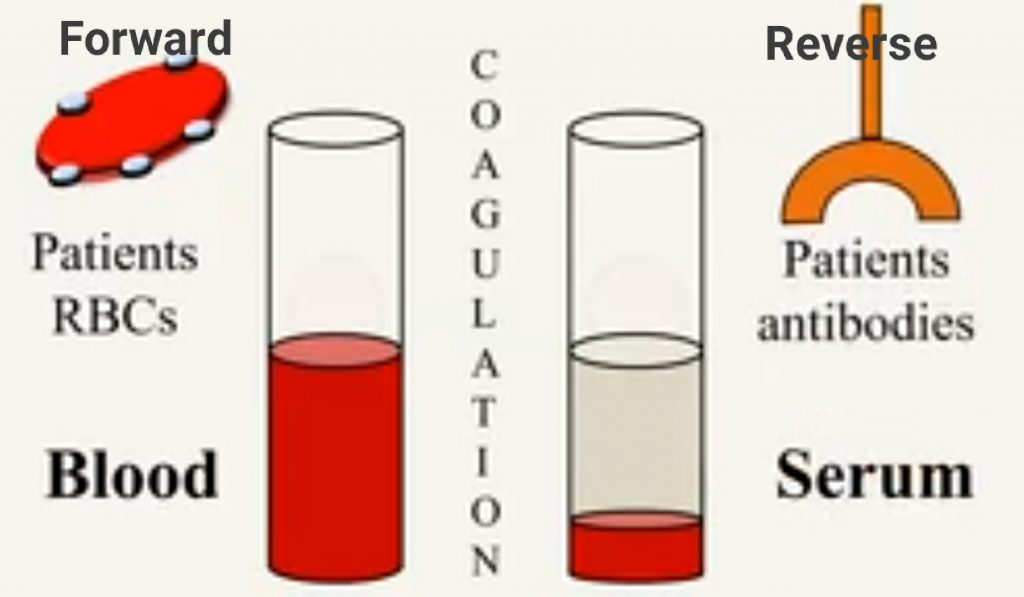Introduction:
ABO grouping is performed in two ways:
Forward grouping/cell grouping: red blood cells are tested for A and B antigens using known anti-A and anti-B sera. (Identification of ABO antigens on red blood cells)
Reverse grouping/serum grouping: serum is tested for anti-A and anti-B antibodies using known A and B red cells. (Identification of ABO antibodies in the plasma)
Reverse blood grouping is a procedure to confirm ABO blood group based on the presence or absence of anti-A and anti-B in serum using known A and B red cells. It is cross check for forward typing. Performing both forward and reverse grouping provides a check for accuracy. Because of the lack of synthesized immunoglobulins, anti-A and anti-B in newborns and very young infants, this procedure is not performed on infants below 4 months of age.
Reverse typing refers to the testing of patients serum for the presence of ABO antibodies.
Principle:
The reverse blood grouping procedure is based on the principle of direct hemagglutination. The erythrocytes of a person contain blood group antigens on the surface of the membrane. When these antigens are allowed to treat with corresponding antibodies, antigen-antibody reaction occurs and form agglutination.
Requirement:
Specimen:
Serum is specimen for reverse blood grouping. No special preparation of the patient is required prior to collection. The specimen should be tested as soon as possible after collection, but specimens may be stored at 2 to 8 degree Celsius, if there is a delay in testing. Storage may result in weaker-than-normal reactions.
Cell Suspension:
Although red cell reagents for serum grouping are available commercially, most laboratories prepare their own A and B test red cells from persons known to be group A and group B. Make pooled cell suspension as follows:
Label tubes as A and B.
Tube A: Place 1 drop of red cells each from 3 of A group samples.
Tube B: Place 1 drop of red cells each from 3 of B group samples.
Add Normal saline and to suspend the cells. Centrifuge the tubes for at least 1 minute at 1000 rpm. To make 5% red cell suspension, add 1 drop of RBC to 19 drops of saline. Make 20% suspension for slide method.
Test the pooled cells prepared by adding the antisera (Anti-A, B) in use.
Procedure:
The reverse blood grouping can be performed in two methods: Tube and Slide method. The Tube method is preferred to slide method.
Tube Method
- Label two test tubes as A and B.
- Add two drops of serum to be tested in each tube.
- Add one drop each of A and B cells suspension to the corresponding test tubes.
- Mix well and centrifuge both tubes at 1000 rpm for 1 minute.
- Gently remove the tubes and completely resuspend cells and examine macroscopically for agglutination and if negative, microscopically.
- Record the reactions and interpret the results.

Tube method 
Slide method
Slide Method
- Mark a clean slide into two halves, labeling the left and right side side as A and B.
- Add a drop of serum to be tested on both sides.
- Add one drop each of A and B cells suspension (20%) to the corresponding sides.
- Using a clean applicator stick, mix the serum and cell suspension on both sides separately and spread into a smooth round circle.
- Rock the slide gently for 2 minutes and look for agglutination.
- Record the reactions and interpret the results.
Results and Interpretation:
If agglutination is observed with A cells only, then the patient’s blood group is B
If agglutination is observed with B cells only, then the patient’s blood group is A
If agglutination is observed with both A and B cells, then the patient’s blood group is O
If agglutination is not observed with both A and B cells, then the patient’s blood group is AB
Limitations:
- Serum from persons with agammaglobulinemia may not contain detectable ABO antibodies.
- As naturally occuring anti-A and anti-B are only formed 3-4 months after birth, it is not suitable for newborns and infants. Antibodies at this age are commonly of maternal origin.























